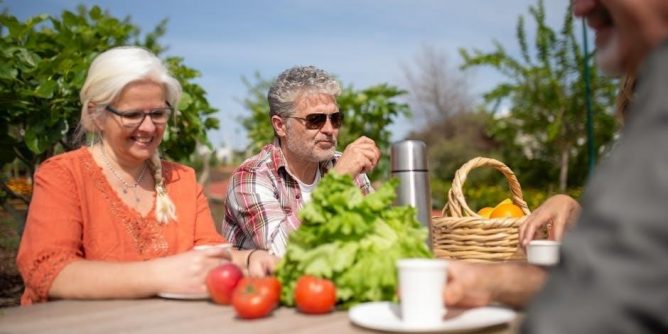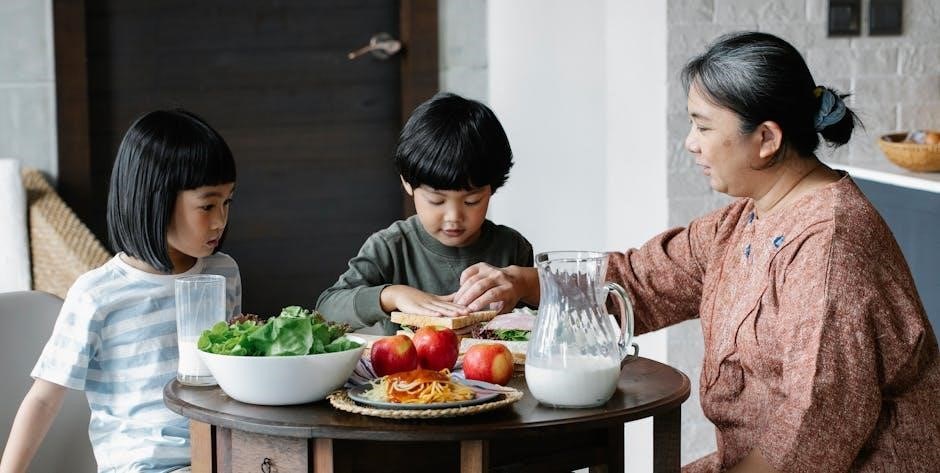
Senior center lunch menus provide nutritious meals tailored to seniors’ dietary needs, fostering health and social interaction. Many centers offer downloadable PDF menus for convenience.
1.1 Overview of Senior Center Services

Senior centers offer a variety of services tailored to support older adults, including meal programs, social activities, and access to community resources. These centers often provide transportation, health workshops, and recreational opportunities. Lunch programs are a key component, ensuring seniors receive nutritious meals while fostering social interaction. Many centers also offer downloadable PDF menus, making it easy for participants to plan and access meal options. By addressing both nutritional and social needs, senior centers play a vital role in promoting overall well-being and independence for older adults in their communities.

1.2 Importance of Nutritional Programs for Seniors
Nutritional programs for seniors are vital for maintaining health and combating malnutrition, which is common among older adults. Proper nutrition supports energy levels, immune function, and chronic disease management. Senior center lunch menus are designed to provide balanced meals that cater to specific dietary needs, ensuring seniors receive essential nutrients. These programs also promote social interaction, reducing feelings of isolation. By offering accessible and affordable meal options, senior centers play a crucial role in improving overall well-being and quality of life for older adults in their communities.

Benefits of Senior Center Lunch Menus
Senior center lunch menus offer health benefits through nutritious meals, foster social connections, and provide economic savings, making them a valuable resource for older adults.
2.1 Health Benefits for Seniors
Senior center lunch menus are designed to meet the nutritional needs of older adults, promoting healthy aging. Meals are balanced, providing essential vitamins, minerals, and proteins; They help combat malnutrition, common among seniors, and support chronic disease management. Nutrient-rich meals improve energy levels, strengthen immunity, and enhance overall well-being. Many programs consult with nutritionists to ensure meals cater to specific health requirements, offering options for dietary restrictions like diabetes or low sodium. Regular, wholesome meals contribute to better physical and mental health, helping seniors maintain independence and quality of life.
2.2 Social Benefits of Community Dining
Community dining at senior centers fosters social connections, reducing loneliness and isolation. Shared meals create opportunities for conversation, friendship, and a sense of belonging. Seniors often look forward to these gatherings, which break the monotony of daily routines. The collaborative atmosphere encourages interaction, helping to build stronger community bonds. Many centers also organize activities around meal times, further enhancing social engagement. These interactions contribute to emotional well-being, combating depression and cognitive decline. Community dining becomes more than just a meal—it’s a vital social experience that enriches seniors’ lives and promotes overall quality of life.
2.3 Economic Benefits for Seniors
Senior center lunch programs offer significant economic benefits, providing affordable, nutritious meals at a lower cost than preparing food at home. This reduces financial strain on seniors, many of whom live on fixed incomes. By offering subsidized meals, these programs help stretch budgets, allowing seniors to allocate resources to other essential needs. Additionally, the convenience of community dining eliminates the expense of groceries and cooking, further supporting financial stability. This cost-effective solution ensures seniors can enjoy healthy meals without compromising their economic well-being, making it a vital resource for aging populations.
How to Access Senior Center Lunch Menus
Seniors can access lunch menus by visiting local centers, downloading PDF versions online, or contacting the center directly for registration and menu details.

3.1 Finding Senior Centers in Your Area
To locate senior centers offering lunch programs, search online using specific keywords like “senior center near me” or “senior lunch programs [your city].” Use Google with phrases in quotes for precise results. Check local government websites or directories like the National Council on Aging. Contact the Area Agency on Aging for referrals. Visit centers in person to inquire about meal services and obtain PDF menus. This approach ensures access to nearby facilities providing nutritious meals and community engagement.
3.2 Downloading Lunch Menus in PDF Format
Many senior centers provide lunch menus in PDF format on their official websites. Visit the center’s site, navigate to the “Dining” or “Meal Programs” section, and search for “Download Menu” or “Lunch Menu PDF.” Some centers, like the Jonesborough Senior Center, allow users to download menus directly or request them via email. Ensure the PDF is up-to-date for current offerings. If the menu isn’t available online, contact the center for assistance. This convenient option helps seniors and caregivers plan meals and stay informed about nutritional options and scheduling.
3.3 Registration Process for Lunch Programs
Registering for senior center lunch programs typically involves simple steps. Visit the center’s website or call directly to inquire about eligibility and enrollment. Many centers, like the Jonesborough Senior Center, allow sign-ups by phone or in person. Provide necessary details such as name, contact information, and any dietary restrictions. Some programs may require advance notice for meal reservations. Once registered, participants can enjoy convenient access to nutritious meals and community engagement. Centers often accommodate walk-ins, but pre-registration ensures meal availability. Check specific center policies for exact procedures and deadlines to secure your spot.

Key Features of Senior Center Lunch Menus
Senior center lunch menus emphasize nutrition, variety, and dietary accommodations, ensuring balanced meals that cater to diverse needs and preferences among older adults.
4.1 Nutritional Considerations
Senior center lunch menus prioritize nutritional balance, ensuring meals are rich in essential vitamins, minerals, and proteins. They often collaborate with dietitians to create dishes that support healthy aging, addressing common senior health concerns like diabetes and hypertension. Meals are designed to be low in sodium and added sugars while incorporating whole grains, lean proteins, and fiber-rich vegetables. Portion control is carefully managed to meet caloric needs without overindulgence. These menus also emphasize hydration by offering water and herbal teas. The goal is to provide meals that are not only nourishing but also flavorful, encouraging regular participation in the lunch program.
4.2 Meal Variety and Seasonal Options
Senior center lunch menus often feature a diverse selection of dishes to cater to varied tastes and preferences. Seasonal ingredients are frequently incorporated to ensure freshness and variety, with meals rotating throughout the year. This approach not only keeps the menu exciting but also supports local farmers and sustainable practices. From hearty soups in winter to light salads in summer, the options are designed to be appealing and nutritious. Additionally, cultural and holiday-themed meals are occasionally offered, adding a festive touch and fostering a sense of community among participants.
4.3 Accommodations for Dietary Restrictions
Senior center lunch menus often accommodate various dietary restrictions to ensure inclusivity and accessibility. Common accommodations include low-sodium, low-sugar, gluten-free, and vegetarian options. Additionally, meals can be tailored for individuals with specific medical conditions, such as diabetes or food allergies. Centers typically request dietary information during the registration process to prepare meals accordingly. This attention to detail ensures that all participants can enjoy nutritious and safe meals, promoting health and well-being while fostering a welcoming environment for everyone.

The Role of Senior Centers in the Community
Senior centers serve as vibrant community hubs, offering social activities, health resources, and educational programs, while providing accessible lunch services that promote well-being and community engagement.
5.1 Promoting Healthy Aging
Senior centers play a crucial role in promoting healthy aging by offering balanced meals that cater to seniors’ nutritional needs. These meals are designed to support physical health, mental well-being, and overall longevity. By providing access to wholesome food, senior centers help combat malnutrition and related health issues. Additionally, they often collaborate with nutritionists to ensure meals are tailored to specific dietary requirements, further enhancing their impact on seniors’ health and quality of life. This proactive approach fosters a supportive environment for aging gracefully and maintaining independence.
5.2 Building Social Connections
Senior centers foster social connections through communal dining experiences, reducing loneliness and isolation among older adults. Sharing meals encourages conversation and camaraderie, helping seniors build friendships. These gatherings also provide opportunities to engage in group activities, fostering a sense of belonging. By creating a welcoming environment, senior centers help combat social isolation, which is crucial for mental and emotional well-being. The availability of lunch menus in PDF format further simplifies participation, ensuring everyone can join and connect with others in their community.
5.3 Providing Access to Resources
Senior centers often serve as hubs for accessing essential resources, offering more than just meals. Many provide information on health services, transportation, and community programs. Lunch programs at these centers frequently coincide with workshops, educational seminars, and wellness checks. Additionally, staff members are often trained to connect seniors with local resources, such as housing assistance, legal aid, and mental health support. By attending lunch programs, seniors gain access to a network of services that enhance their overall quality of life and independence.

Common Questions About Senior Center Lunch Menus

Common questions include how to sign up for lunch programs, downloading PDF menus, and registration processes. These inquiries are addressed through center resources and guides.
6.1 How Are Menus Planned?
Senior center lunch menus are planned collaboratively with nutritionists, ensuring meals meet seniors’ dietary needs. Menus consider health conditions, cultural preferences, and seasonal ingredient availability. Fresh, locally-sourced foods are prioritized to maintain nutritional value and flavor. Input from seniors and community members helps tailor offerings, ensuring variety and satisfaction. Meals are designed to promote healthy aging and address common dietary restrictions. Menus are often published in PDF formats for easy access, allowing seniors to plan their meals in advance. This thoughtful planning ensures meals are both enjoyable and beneficial for overall well-being.
6.2 Are Meals Tailored to Specific Needs?
Senior center meals are often tailored to accommodate specific dietary needs, such as low-sodium, diabetic-friendly, or vegetarian options. Nutritionists work closely with chefs to ensure meals meet health requirements while maintaining flavor. Centers may request information about seniors’ dietary restrictions during the registration process. Some programs offer alternative meal options upon request. Menus are designed to cater to a variety of preferences and health conditions, ensuring inclusivity and accessibility. This personalized approach helps seniors maintain their health and well-being while enjoying nutritious meals. PDF menus often highlight accommodations for dietary needs, making it easy for seniors to plan accordingly.
6.3 How Often Do Menus Change?
Senior center lunch menus typically change weekly or monthly, depending on the center’s resources and seasonal ingredient availability. Many centers offer seasonal options to keep meals varied and nutritious, ensuring seniors receive a diverse diet throughout the year. Menu updates are often communicated through newsletters, announcements, or website updates. Some centers may adjust menus more frequently based on senior preferences or dietary needs, while others maintain a consistent schedule. Regular menu changes help keep meals interesting and tailored to the community’s tastes and requirements.
The Importance of Nutrition for Seniors
Nutrition is vital for seniors, supporting overall health, preventing chronic diseases, and maintaining energy levels. Balanced diets help seniors stay independent and enjoy a better quality of life.
7.1 Maintaining a Balanced Diet
A balanced diet for seniors includes essential nutrients like protein, vitamins, and minerals. Senior center lunch menus are designed to provide these nutrients, ensuring meals are both nutritious and appealing. They often feature a variety of dishes to cater to different tastes and dietary needs. By focusing on whole foods, fruits, vegetables, and lean proteins, these menus help maintain energy levels and support overall health. Regular balanced meals also aid in preventing chronic conditions such as heart disease and diabetes, which are common among older adults. This approach promotes healthy aging and well-being.
7.2 Combating Malnutrition in Older Adults
Senior center lunch programs play a vital role in combating malnutrition among older adults by providing balanced, nutrient-rich meals. Many seniors face challenges such as limited mobility, financial constraints, or difficulty cooking, which can lead to poor nutrition. These programs ensure access to wholesome food, addressing deficiencies in vitamins, minerals, and proteins. Meals are often designed with input from nutritionists to meet seniors’ specific needs, helping to prevent conditions like weight loss, weakened immunity, and chronic diseases. By offering affordable and convenient options, senior centers help seniors maintain their health and quality of life.

7.3 The Role of Hydration
Hydration is a critical aspect of senior health, as older adults often experience reduced thirst sensation and increased risk of dehydration. Senior center lunch menus emphasize the importance of water and fluid intake to maintain bodily functions. Many programs include hydration tips in their materials, encouraging seniors to drink water regularly and consume water-rich foods like fruits and vegetables. Proper hydration helps prevent urinary tract infections, constipation, and dizziness, while supporting overall physical and cognitive health. Senior centers often remind participants to stay hydrated, especially during meals and activities, to ensure optimal well-being. This focus on hydration complements the nutritional goals of their meal programs.
How to Create Effective Senior Lunch Menus
Creating effective senior lunch menus involves planning balanced meals, collaborating with nutritionists, and budgeting efficiently to ensure affordability and accessibility for all participants.
8.1 Planning Nutritious Meals
Planning nutritious meals for seniors involves considering their dietary needs, incorporating essential nutrients, and ensuring variety. Meals should be balanced, with lean proteins, whole grains, and fresh vegetables. Collaboration with nutritionists helps design menus that support healthy aging and address common health issues like diabetes or heart conditions. Seasonal ingredients can add variety and keep costs manageable. Offering options that cater to different tastes and dietary restrictions ensures inclusivity. Regular reviews of menu plans help maintain quality and relevance, ensuring seniors receive meals that are both nourishing and enjoyable.
8.2 Collaborating with Nutritionists
Collaborating with nutritionists ensures that senior center lunch menus meet seniors’ nutritional needs. Nutritionists assess dietary requirements, considering health conditions and allergies, to create balanced meals. They design menus that promote healthy aging, combat malnutrition, and support chronic disease management. Regular consultations with nutritionists help adapt recipes to suit seniors’ preferences while maintaining nutritional value. This collaboration also ensures meals are culturally appropriate and appealing, fostering a positive dining experience. By involving nutritionists, senior centers guarantee that their lunch programs provide optimal health benefits and cater to the diverse needs of their community.
8.3 Budgeting for Meal Programs
Budgeting for senior center meal programs involves careful financial planning to ensure affordability and sustainability. Centers allocate funds for ingredients, labor, and facilities, often relying on grants or donations. Cost-effective meal planning focuses on seasonal ingredients and bulk purchases to minimize expenses. Budgets also cover dietary accommodations, such as gluten-free or low-sodium options, ensuring inclusivity. Financial transparency and regular audits help maintain trust and accountability. By optimizing resources, senior centers deliver nutritious meals while staying within budget, making their programs accessible to all seniors in the community.
The Future of Senior Center Lunch Programs
The future of senior center lunch programs includes innovations like home delivery options, expanded menu variety, and increased accessibility for all seniors.
9.1 Innovations in Meal Delivery
Innovations in meal delivery for senior centers include home delivery services, partnerships with meal kit providers, and technology-driven solutions like AI-powered apps for personalized nutrition plans. These advancements aim to enhance accessibility, especially for seniors with mobility challenges. Additionally, some centers are exploring eco-friendly packaging and sustainable delivery methods to reduce environmental impact. These innovations not only improve meal quality but also ensure that seniors receive nutritious food conveniently, promoting their overall well-being and independence. Such forward-thinking approaches are reshaping how senior centers deliver meals, making them more adaptable to modern lifestyles and dietary needs.
9.2 Expanding Menu Options
Expanding menu options in senior centers aims to cater to diverse tastes, dietary needs, and cultural preferences. Centers are introducing more varied cuisines, including international dishes, to keep meals engaging. Seasonal ingredients are being incorporated to ensure freshness and variety. Additionally, there is a growing emphasis on accommodating special diets, such as vegetarian, gluten-free, and low-sodium options. This expansion not only enhances meal satisfaction but also ensures seniors receive balanced nutrition tailored to their health requirements. By offering a wider range of choices, senior centers promote inclusivity and make mealtime more enjoyable for all participants.
9.4 Increasing Accessibility
Efforts to increase accessibility ensure senior center lunch programs reach more individuals. Many centers now offer PDF menus online, allowing seniors to view options from home. Mobile-friendly formats cater to tech-savvy seniors, while large print versions assist those with vision impairments. Delivery services for homebound seniors are expanding, ensuring meals reach those unable to visit centers; Partnerships with local organizations help distribute menus to isolated communities. By addressing physical, visual, and technological barriers, senior centers are making their lunch programs more inclusive and accessible, ensuring all seniors can benefit from these vital resources.